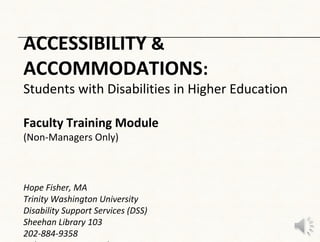
Audio practiceA
- 1. ACCESSIBILITY & ACCOMMODATIONS: Students with Disabilities in Higher Education Faculty Training Module (Non-Managers Only) Hope Fisher, MA Trinity Washington University Disability Support Services (DSS) Sheehan Library 103 202-884-9358
- 2. TRAINING OBJECTIVES Through this training, participants will be able to: 1.Provide an example of appropriate language and behavior towards people with disabilities. 2.Describe the two major roles that faculty are responsible for incorporating into their work at Trinity. 3.Articulate three or more concrete strategies that they will implement, to promote accessibility and inclusion.
- 3. INTRODUCTION & OUTLINE I. Defining and Discussing Disability Appropriately • Legal Definition of Disability • Disability Etiquette I. Framework and Practical Applications • Data Trends in Disability and Higher Education • Accessibility and the Law: Staff Role #1 • Help from Universal Design Principles • Disability Services and Accommodations I. Working with Disability Support Services: Staff Role #2 • Overview of Classroom Accommodations I. Adaptive/Assistive Technology Examples
- 4. SECTION I Defining and Discussing Disability Appropriately Legal Definition of Disability + Activity: “Defining Disability” Disability Etiquette + Activity: “Language & Behavior”
- 5. LEGAL DEFINITION OF DISABILITY The primary legislation governing the civil rights of people with disabilities is the Americans with Disabilities Act (ADA), as amended. The ADA defines a disability as: A long-lasting physical, cognitive, or psychological condition that substantially impairs a persons ability to perform major life activities without assistance.
- 6. (cont’d) LEGAL DEFINITION OF DISABILITY ADA Clarification Points: •Major life activities can include: seeing, hearing, walking, learning, speaking, concentrating, and using bodily functions (e.g., digestion, circulation). •The ADA’s protection from discrimination covers those who currently have a disability, who have a record of a disability, and who are regarded as having a disability.
- 7. (cont’d) LEGAL DEFINITION OF DISABILITY Activity: Defining Disability Purpose: To increase comprehension of the definition of “disability”. Directions: I’ll read each of the conditions aloud. Raise your hand, if it IS likely to fall under the ADA definition we just discussed. Deafness Depression Dyslexia Common Cold Sprained Ankle Cerebral Palsy Pregnancy Traumatic Brain Injury Multiple Sclerosis Mild Myopia
- 8. (cont’d) LEGAL DEFINITION OF DISABILITY
- 9. (cont’d) SECTION I Defining and Discussing Disability Appropriately Legal Definition of Disability + Activity: “Defining Disability” Disability Etiquette + Activity: “Language & Behavior”
- 10. (cont’d) DISABILITY ETIQUETTE: YOUR LANGUAGE Tips for everyday communication: 1. Use person-centered language. Name the individual before the disability, as in “a person with ________”. 2. Remove grossly offensive terms (e.g., crippled) from your vocabulary. Also, phase out antiquated terms like “handicapped” or “challenged”. 3. Avoid using unwarranted qualifiers, like “special” or “superhuman”, to describe people with disabilities. 4. Don’t use the disability, as a primary description.
- 11. (cont’d) DISABILITY ETIQUETTE: YOUR BEHAVIOR Tips for everyday interactions: 1. Stay alert of environmental barriers that may pose an issue for those with visual or mobility disabilities. 2. Respect individual privacy. Make sure that others aren’t around when discussing someone else’s disability. 3. Don’t force your “help”. Ask IF and HOW you can assist. 4. Use the same non-verbal cues that you would use with anyone else (e.g., hand-shakes, eye contact).
- 12. (cont’d) DISABILITY ETIQUETTE Activity: Language & Behavior Purpose: To apply disability etiquette concepts to real-world examples. Directions: In your groups, discuss the 3 statements below (from the handout) and determine if each one is MOSTLY TRUE or MOSTLY 1. “When I meet a person who has a disability, I should not FALSE. ask them about their disability.” 2. “It’s not OK to touch someone’s wheelchair or service dog .” 3. “If one of my student’s is accompanied by a personal aide or sign language interpreter, I must speak directly to the aide or interpreter.”
- 13. (cont’d) DISABILITY ETIQUETTE Activity: Language & Behavior 1. “When I meet a person who has a disability, I should not ask them about their disability.” True or False? MOSTLY TRUE. For personal privacy and legal reasons, it is generally NOT a good idea to ask someone about a disability that they have not voluntarily disclosed to you.
- 14. (cont’d) DISABILITY ETIQUETTE Activity: Language & Behavior True or False? MOSTLY TRUE. Avoid leaning on someone’s wheelchair or playing with their service animal. Consider these to be an extension of their body space.
- 15. (cont’d) DISABILITY ETIQUETTE Activity: Language & Behavior MOSTLY FALSE. Similar to wheelchairs and service animals, their purpose is auxiliary. You should speak directly to the person who is conducting business with you.
- 16. STOP